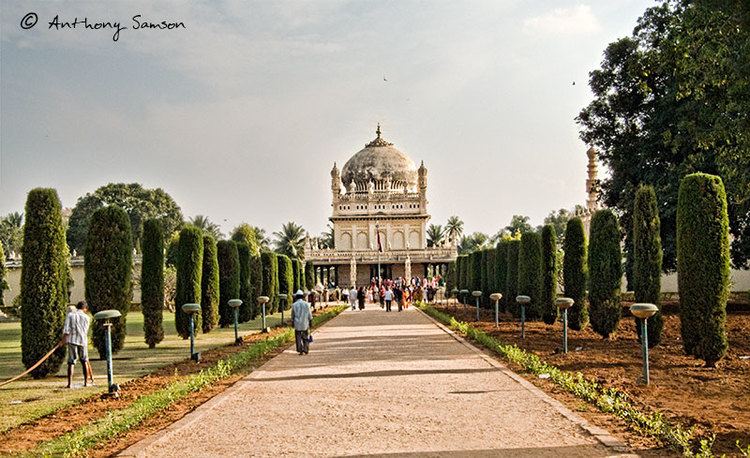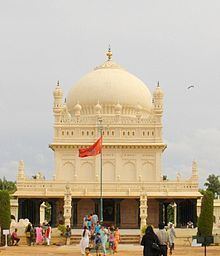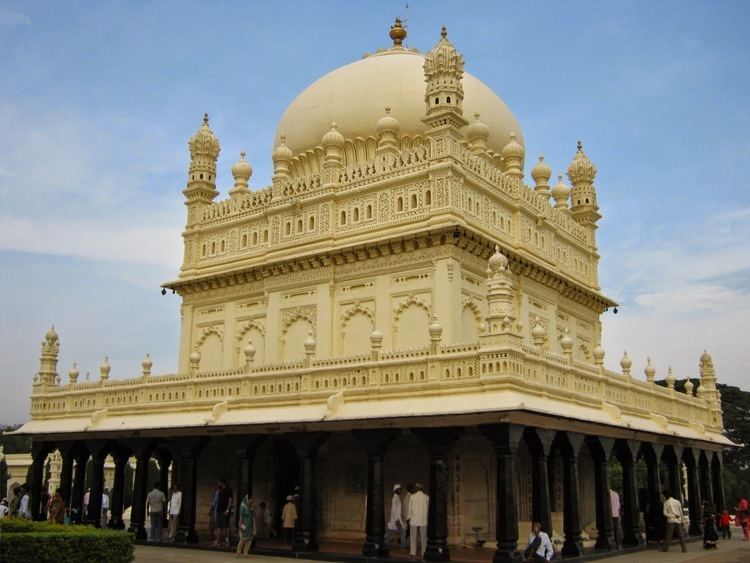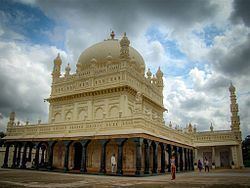Height 20m Material Amphibolite | Type Mausoleum Completion date 1784 Beginning date 1782 | |
 | ||
Similar Daria Daulat Bagh, Brindavan Gardens, Ranganathaswamy Temple - Shivanasamudra, Tipu Sultan's Summer, Ranganathittu Bird Sanctuary | ||
Gumbaz srirangapatna
The Gumbaz at Seringapatam is a Muslim mausoleum at the centre of a landscaped garden, holding the graves of Tippu Sultan, his father Hyder Ali and his mother Fakr-Un-Nisa. It was originally built by Tippu Sultan to house the graves of his parents. Tippu was himself allowed to be buried here by the British, after his death in the Siege of Seringapatam in 1799.
Contents
- Gumbaz srirangapatna
- History
- Architecture
- Burials
- British Occupation 1792
- Robert Homes Description
- Tipus Burial
- Renovation by Lord Dalhousie
- Farsi Epitaphs
- William Baillie Memorial
- His Majestys Cemetery Ganjam
- References
History

The Gumbaz was raised by Tippu Sultan in 1782-84 at Seringapatam, as a mausoleum for his father and mother. The Mausoleum was surrounded by a cypress garden which is said to have different species of flowering trees and plants collected from Persia, Ottoman Turkey, Kabul and French Mauritius, which were collected by Hyder's son and successor, Tippu Sultan.

The original carved doors of the mausoleum have been removed and are now displayed at the Victoria and Albert Museum, London. The present door made of ebony, and beautifully decorated with ivory was gifted by Lord Dalhousie
Architecture

The Gumbaz is designed in the Persian style, with a large rectangle shaped garden, having a path leading to the mausoleum. In the middle of the garden, the Gumbaz stands on an elevated platform. The dome is supported by sharply cut black granite pillars. The doors and windows have lattice work cut through in stone on the same black granite material. The walls inside are painted with tiger stripes, the colours of Tippu Sultan. The three graves of Tippu Sultan, his father Hyder Ali and his mother Fakr-Un-Nisa are located inside the mausoleum. Many of Tippu's relatives are buried outside the mausoleum in the garden. Most of the grave inscriptions are in Farsi. Next to the Gumbaz is the Masjid-E-Aksa, which was also built by Tippu Sultan

The Gumbaz uses the Bijapur style of construction, and consists of a dome placed on a cubical structure, with ornamental railings and turrets decorated with finals which are spherical shaped.The dome is supported by 36 black granite pillars, and has an east facing entrance.
Burials

Inside the mausoleum, the middle grave is that of Hyder Ali, to his east is Tipu Sultan's mother, and to his West Tipu Sultan is buried. On the southern side of the veranda outside are the graves of Sultan Begum - Tipu's sister, Fatima Begum - Tipu's daughter, Shazadi Begum - infant daughter, Syed Shahbaz - Tipu's son-in-law, Mir Mahmood Ali Khan and his father and mother. On the East side is the black grave supposedly of Tipu's foster mother Madina Begum. There is an elevation on the veranda with 3 rows of graves, with the first having no headstones. Another row has 14 graves - 8 women and 6 men, including that of Malika Sultan e Shaheed or Ruqia Banu, Burhanuddin Shaheed - brother-in-law of Tipu and brother of Ruqia Banu, Nizamuddin and 1 unmarked grave. The third row consists of 14 graves, 9 women and 5 men and includes Nawab Muhammad Raza Ali Khan or Ban Ki Nawab who was killed in the Battle for Coorg, and an unidentified grave. On the northern side, there are many rows of graves of both sexes, with only a few having headstones.
British Occupation, 1792
The grounds of the Gumbaz was briefly occupied by British India forces in 1792, towards the end of the Third Anglo-Mysore War. The army camped on the grounds, and cut down many cypress trees in the garden surrounding the tomb of Hyder Ali, to be used as tent poles and fascines. The flower beds surrounding the mausoleum were dug up for burial of those who fell in the battle. The landscaped lawns were used to exercise the horses, and the walkways used for target practice. The choultary meant for the Muslim fakirs were converted into a makeshift hospital to treat the battle wounded. These scenes were depicted in the illustrations by the military artist Charles Gold's book Oriental Drawings published in 1806. His painting shows Hyder Ali's tomb rising to the skies, but with a backdrop scene of British soldiers camping in the gardens. British forces wearing red coats with axes, cutting down the cypress trees, directing Indian workers to carry away the wood, and generally disrupting the garden.
Charles Gold describes the scene as
During this occupation, the Gumbaz was sketched by military artists such as Charles Gold, James Hunter (d. 1792), Robert Home (1752-1834) and Sir. Alexander Allan (1764-1820), as shown in the vintage gallery below.
Robert Home's Description
Robert Home, the official military artist the Madras Army led by Lord Cornwallis, sketched the Gumbaz (see Vintage Gallery above) and described it. According to Home, the gardens called the Lal Bagh (garden of rubies), covered a third of the river island and was the largest garden in the Mysore Kingdom. The garden was landscaped beautifully with designs which was a combination of several Asian traditions, and in its middle was the mausoleum of Tipu's father Hyder Ali. He further describes the garden during the British occupation at the end of the Third Anglo-Mysore War as
Tipu's Burial
Tipu Sutan was buried at the Gumbaz, next to the graves of his father and mother, in a hurried move, after his death in the Fourth Anglo-Mysore War in 1799. The burial took place the next day after the end of the war, on 5 May 1791 at 5 May. The British allowed for Tipu to be buried at the Gumbaz, next to his father's grave, and also provided full military honours for his funeral. The body was carried in a procession, accompanied by European soldiers of the Grenadier division. The chief mourner was Tipu's son Abdul Khaliq, followed by some officials and people. A severe thunderstorm is recorded to have struck Seringapatam at the time his body was buried.
The burial of Tipu Sultan is described by many British Officers such as Lieutenant Richard Bayly of the 12th Regiment. According to Lieut. Bayly
Renovation by Lord Dalhousie
In 1855, Lord Dalhousie, Governor-General of India visited Seringapatam on his way to the Nilgiris. During his visit he found most of the monuments in a state of neglect, slowing falling into decay. He then ordered that buildings to be renovated and maintained, as they not only provided memories for the war for the Deccan, and the exploits of the Duke of Wellington, but were also architecturally beautiful. Lord Dalhousie also paid for the replacement doors for the Gumbaz. Dalhousie also ordered for the murals in the Daria Daulat to be restored, and the building be repaired, a sum approved for the annual maintenance of Daria Daulat, Gumbaz and other associated monuments. A minute to this effect was recorded by his staff, and a fund was established for the maintenance of these monuments at Seringapatam
Farsi Epitaphs
The Farsi epitaphs at the Gumbaz were studied by Benjamin Lewis Rice and appear in his work, Epigraphia Carnatica: Volume III: Inscriptions in the Mysore District (1894)
William Baillie Memorial
In the gardens of Lalbagh, next to the Gumbaz is located the memorial for William Baillie. The memorial was commissioned, 35 years after Col Baillie's death, and 17 years after the fall of Tippu Sultan, by William's nephew Lt. Col. John Baillie, who served as the British Resident in the Court of the Nawab of Oudh, Lucknow. It is an austere, but poignant and pretty structure.
His Majesty's Cemetery, Ganjam
According to Rev. E W Thompson and other accounts, there used to exist a Madras Army cemetery called His Majesty's Cemetery at Ganjam, near the Gumbaz (a short distance in the North-West direction), much before the Garrison Cemetery. The cemetery was enclosed by a wall, with an inscription on the gate-post, His Majesty's Cemetery, Ganjam, a.d. 1799-1808. It contains burials between 1799 and 1808, mainly from the 33rd Regiment. Daniel Pritchard, the music master of this regiment was buried at this cemetery in July 1799. Elinda Harmonci, a child aged 4 years was also buried here in November 1799.
Col. Edward Montague of the Bengal Artillery, died 8 May 1799, 4 days after the final assault is buried near the Sangam, on the extreme east end of the island.
